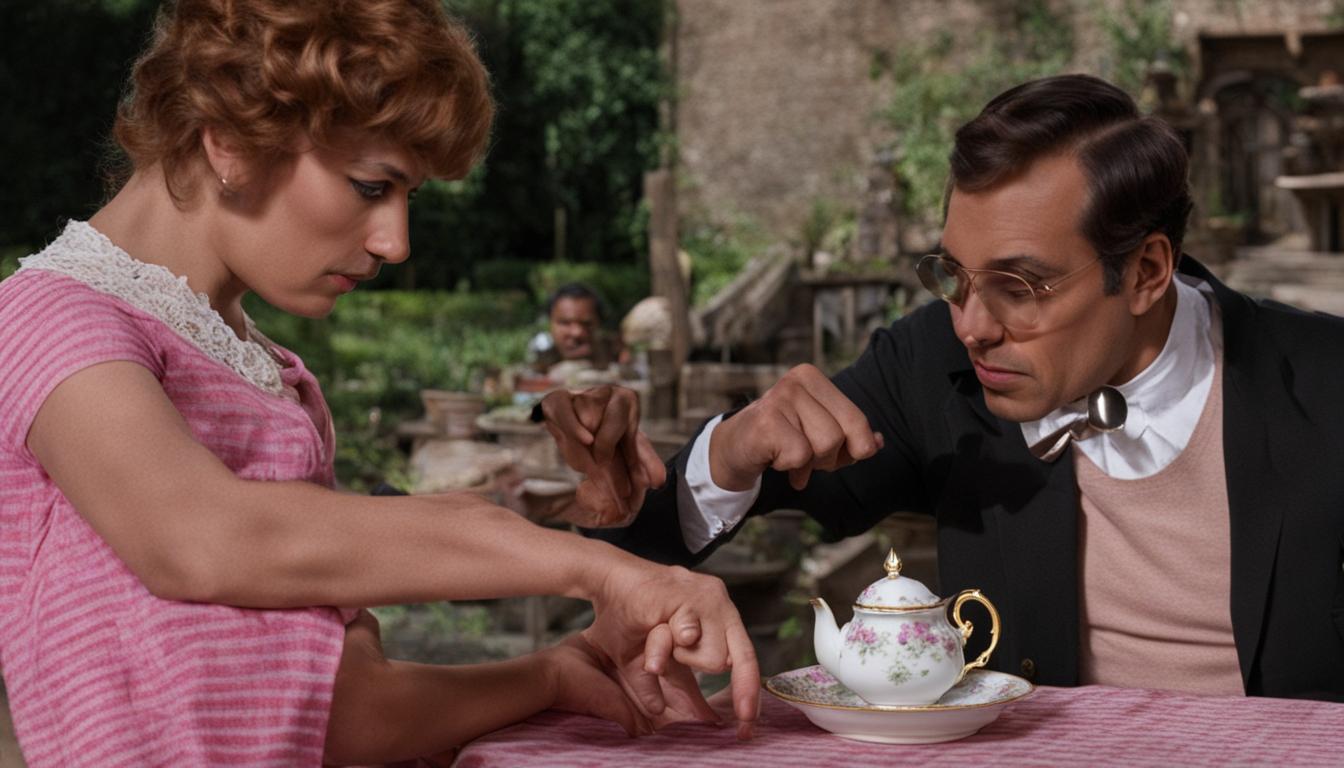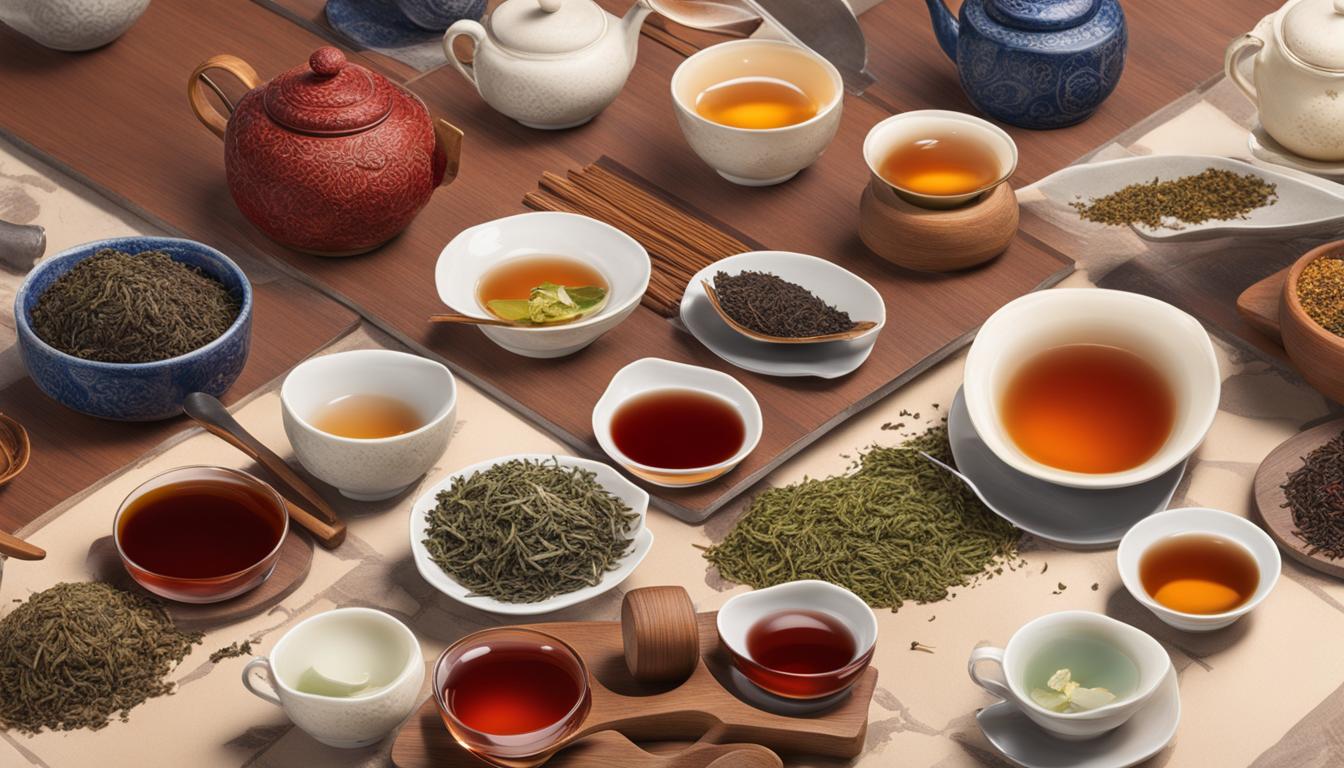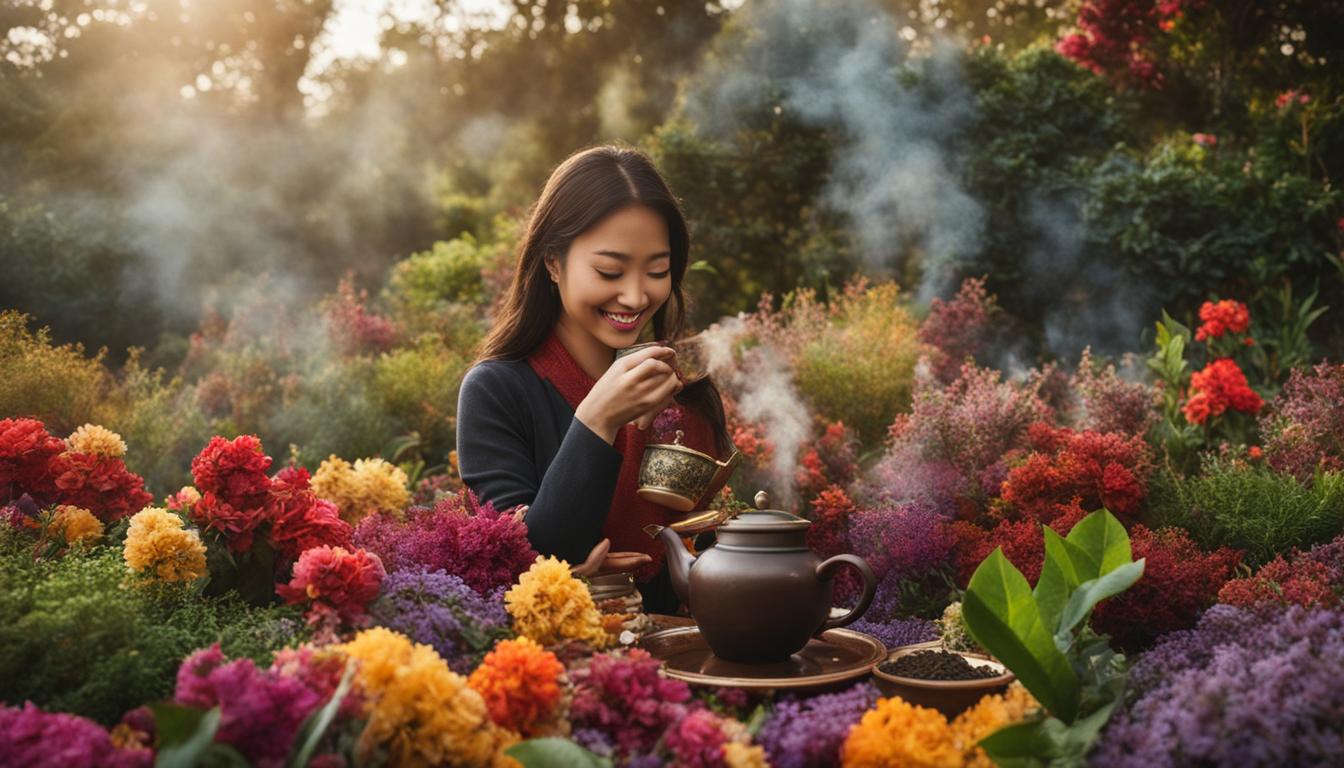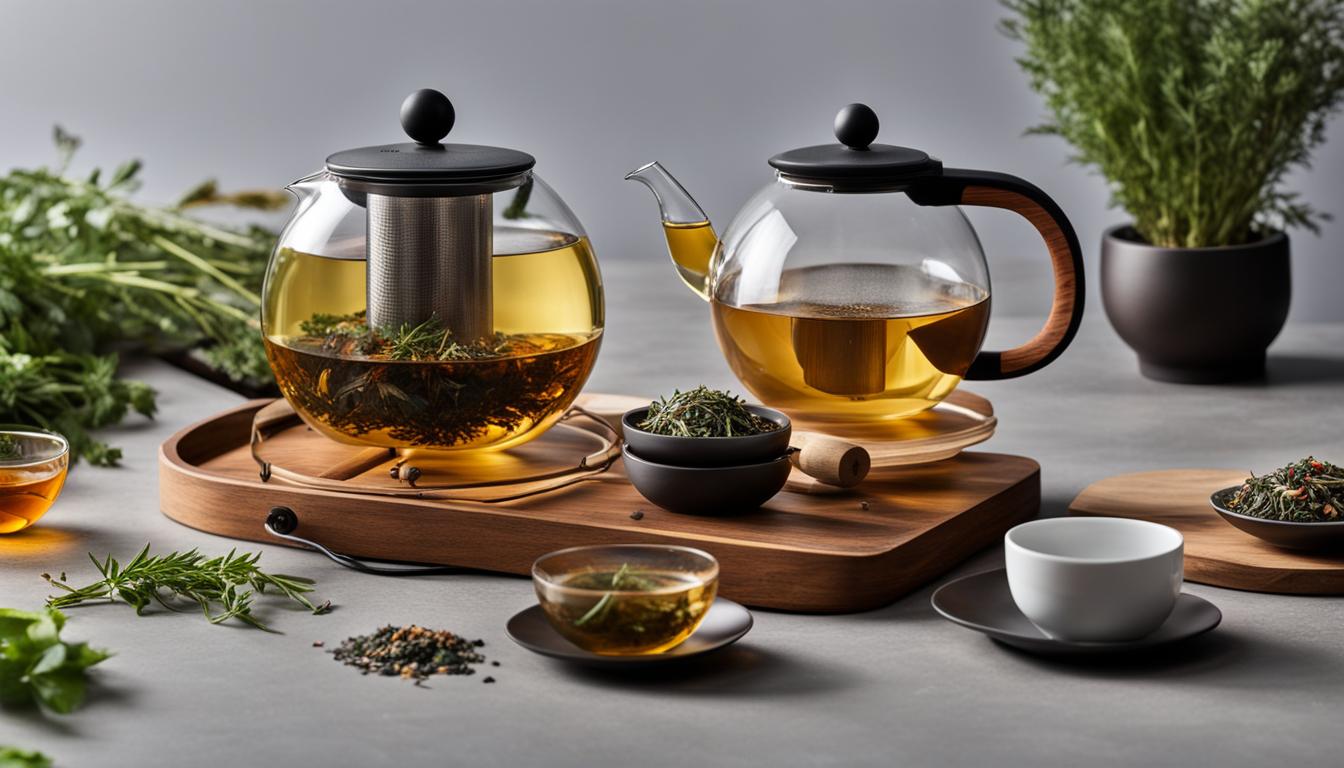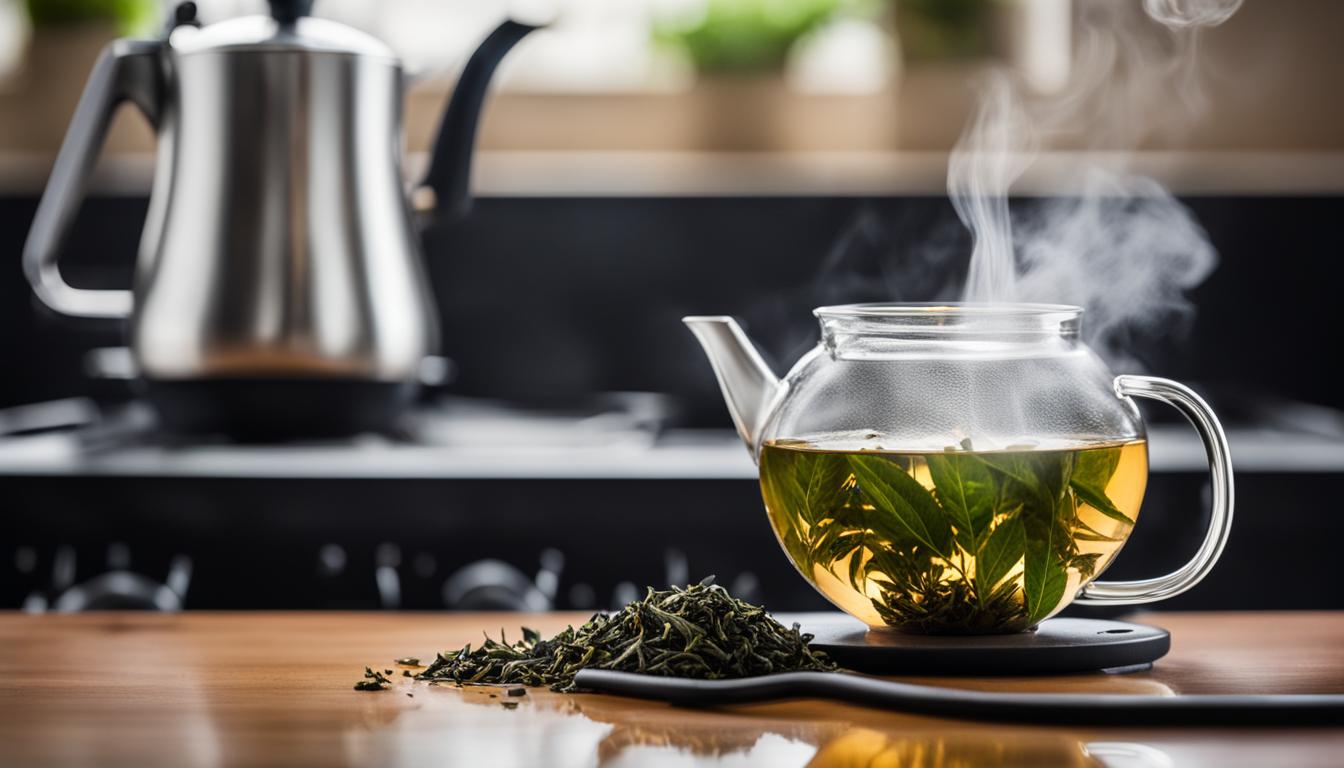Tea tasting is a time-honored tradition steeped in tradition and proper etiquette. To fully appreciate the flavors and aromas of tea, it’s important to understand and practice proper tea tasting manners. So, whether you’re a seasoned tea connoisseur or just starting your tea journey, here are some essential do’s and don’ts to keep in mind:
Key Takeaways:
- Respect tea tasting as a tradition by following proper etiquette.
- Hold your teacup correctly using the handle and support it with your fingers.
- When serving tea, pour for your guests and leave room in the teacup for milk and sugar.
- Practice patience in tea tasting, allowing the tea to cool naturally and savoring its flavors.
- Chinese tea ceremonies have their own unique set of etiquette rules.
How to Hold Your Teacup Properly
Holding your teacup correctly is an essential part of tea tasting etiquette. The way you hold your teacup can reflect your level of sophistication and understanding of proper conduct in tea tasting. Follow these guidelines to master tea tasting etiquette and impress fellow tea enthusiasts.
To hold your teacup properly, start by using your index and middle fingers to grasp the back side of the handle. Your thumb should rest gently on the front side of the handle, creating a stable grip. Support the weight of the teacup with your ring and pinky fingers placed underneath the base. Remember to keep your pinky finger down, contrary to the common misconception that it should be raised.
| DO | DON’T |
|---|---|
| Hold the teacup by the handle using your index and middle fingers | Hold the teacup with all fingers wrapped around the body |
| Support the teacup with your ring and pinky fingers | Hold the teacup with only your thumb and index finger |
| Keep your pinky finger down | Stick your pinky finger out |
By holding your teacup correctly, you allow the flavors and aromas of the tea to be fully appreciated, while demonstrating your understanding and respect for tea tasting traditions. So remember, the next time you attend a tea tasting, hold your teacup with poise and elegance.
The Art of Sipping Tea
In addition to holding your teacup properly, the way you sip your tea also contributes to tea tasting etiquette. Take small, controlled sips to fully experience the flavors and aromas of the tea. Avoid slurping or gulping your tea, as this can be considered impolite and disruptive to the tasting experience. Instead, savor each sip and allow the tea to coat your palate, allowing you to appreciate its nuances.
Remember, tea tasting is a sensory experience that engages all your senses. By mastering the art of holding your teacup and sipping tea with grace, you can enhance your tea tasting journey and become a true connoisseur.
Pouring and Serving Tea with Grace
When it comes to tea tasting etiquette, pouring and serving tea is a crucial element. As the host, it is your responsibility to demonstrate respect and create a pleasant atmosphere for your guests. Properly pouring and serving tea showcases your appreciation for this traditional practice. Here are some guidelines to follow:
Table: Tea Pouring and Serving Guidelines
| Guideline | Description |
|---|---|
| Always pour for your guests | Show respect and friendship by serving tea to your guests. This gesture demonstrates hospitality and ensures everyone feels valued. |
| Leave room for customization | When pouring tea, avoid filling the teacup to the brim. Leave approximately three-quarters of the cup empty to allow guests to add milk, sugar, or other preferred additions. |
| Handle the teapot with care | When pouring the tea, hold the teapot’s handle with poise and avoid any unnecessary spills. Practice steady and controlled movements to maintain gracefulness. |
| Pour from a lower height | When pouring the tea, aim to pour from a lower height to avoid any potential splashing or spilling. This helps ensure a smooth and elegant pouring experience. |
Remember:
- Do not fill the teacup to the top; leave room for customization.
- Handle the teapot with care and pour from a lower height to maintain gracefulness.
- Ensure everyone’s teacup is filled before you start pouring for yourself.
- Observe your guests’ preferences for milk, sugar, or other additions and accommodate their choices.
By following these guidelines, you will not only demonstrate proper tea tasting etiquette but also create a welcoming and enjoyable tea tasting experience for yourself and your guests.
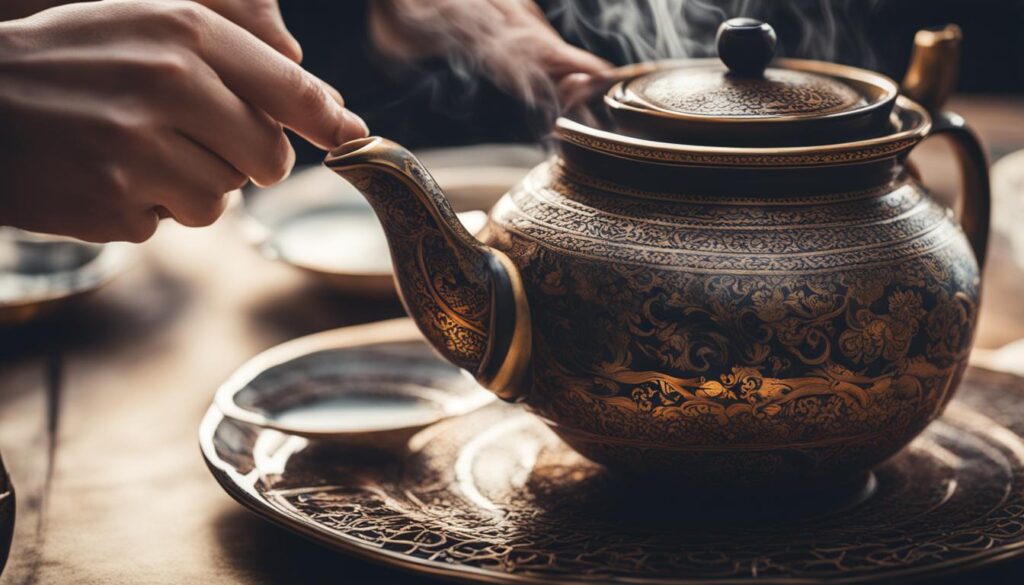
The Importance of Patience in Tea Tasting
When it comes to tea tasting, patience is not just a virtue – it’s an essential part of the experience. In our fast-paced world, taking the time to slow down and truly savor the flavors and aromas of tea is a luxury worth indulging in. So put away your impatience and embrace the art of mindful tea tasting.
One key aspect of patience in tea tasting is allowing your tea to cool naturally before taking a sip. While it may be tempting to blow on your tea to speed up the process, this is considered impolite in tea tasting etiquette. Instead, use this time to appreciate the beautiful color and fragrance of the tea as it gradually cools down.
“Tea is a drink that should be savored, not rushed. Take your time and let the flavors unfold on your palate.”
Another important element of patience in tea tasting is taking the time to observe and appreciate the nuances of each sip. Tea is a complex beverage with layers of flavors and aromas waiting to be discovered. By taking slow, deliberate sips and allowing the tea to linger on your palate, you can fully experience the depth and intricacy of the tea.
So the next time you find yourself in a tea tasting session, resist the urge to rush through it. Sit back, relax, and let patience guide you on a sensory journey. Your taste buds will thank you.
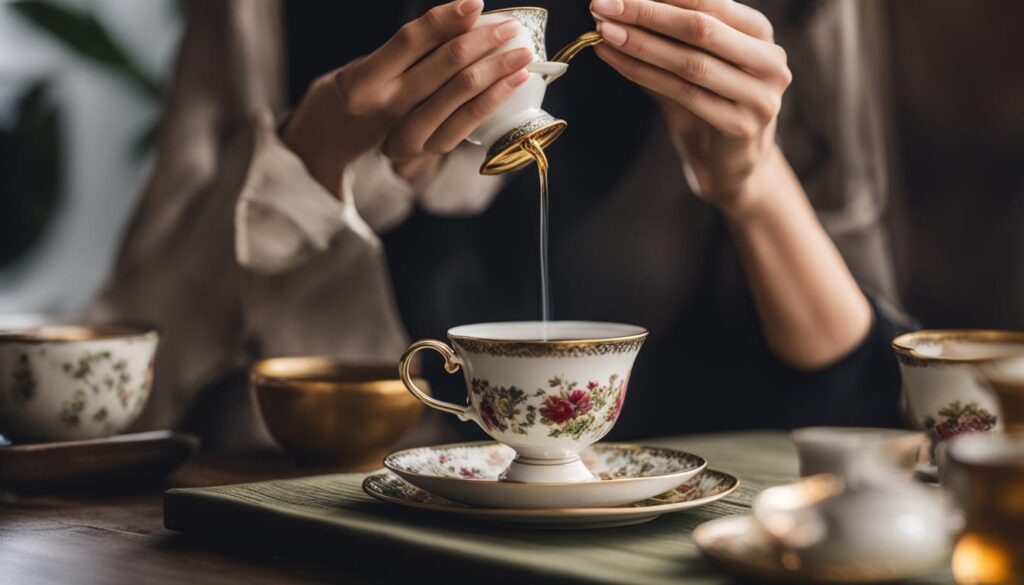
Chinese Tea Tasting Etiquette
Chinese tea ceremonies have a rich history and their own set of etiquette rules. Understanding and respecting these customs can enhance your tea tasting experience. Let’s explore some guidelines for Chinese tea tasting etiquette.
Seating Arrangements
In a traditional Chinese tea ceremony, seating arrangements are crucial. The host’s left side is considered the first guest of honor, followed by guests of descending importance. This seating hierarchy reflects respect and social status. It’s important to be mindful of these arrangements when attending or hosting a tea tasting.
Expressing Gratitude
Expressing gratitude for the first steep of tea is customary in Chinese tea ceremonies. This gesture shows appreciation to the person serving the tea and acknowledges the effort put into preparing it. It’s a small but meaningful way to show respect for the tea and the host.
Don’ts to Keep in Mind
During a Chinese tea ceremony, there are a few don’ts to keep in mind. Firstly, avoid drinking up the tea at once. Instead, take small sips and savor the flavors. Being absent-minded or distracted during the ceremony is also considered impolite. Show respect by staying engaged and focused on the tea tasting experience.
| Chinese Tea Tasting Etiquette | Do’s | Don’ts |
|---|---|---|
| Seating Arrangements | Respect the seating hierarchy | Disregard the seating arrangements |
| Expressing Gratitude | Show appreciation for the first steep of tea | Fail to acknowledge the effort put into preparing the tea |
| Stay Engaged | Focus on the tea tasting experience | Be absent-minded or distracted |
By following these Chinese tea tasting etiquette guidelines, you can fully immerse yourself in the tradition and culture surrounding tea ceremonies. Remember to be respectful, express gratitude, and stay engaged throughout the ceremony. Let the tea transport you to a world of flavor and tradition.
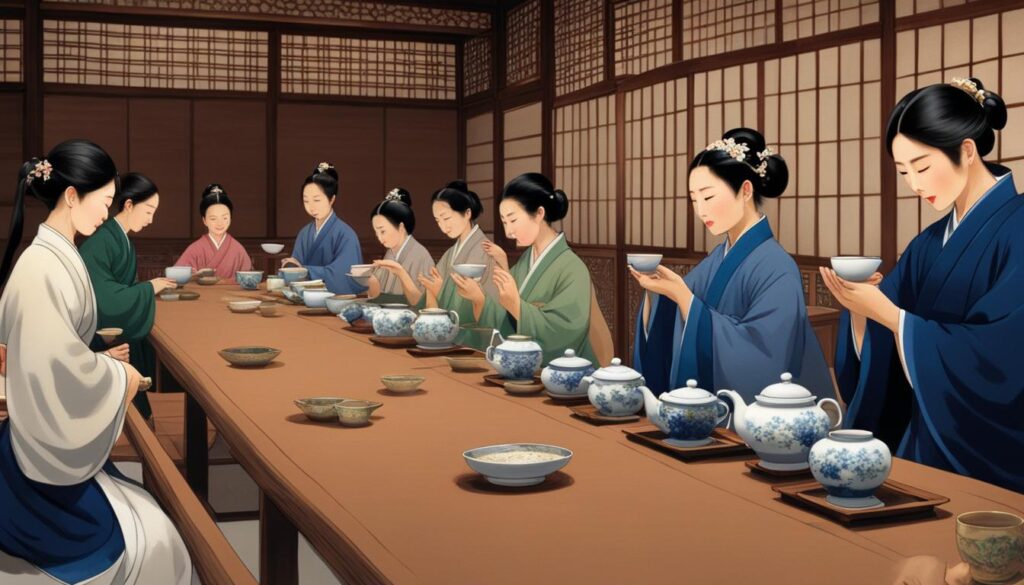
Conclusion
Tea tasting etiquette is the key to truly mastering the art of appreciating tea. By following proper manners and practices, we can enhance our tea tasting experience and show respect to the tea and those around us.
First and foremost, holding the teacup with grace is essential. Remember to use your index and middle fingers on the back side of the handle, with your thumb over the front. Support the teacup delicately with your ring and pinky fingers, keeping your pinky down for that touch of elegance.
In addition to holding the teacup correctly, pouring and serving tea with finesse is another aspect of tea tasting etiquette. As the host, it is customary to pour tea for your guests. Ensure there is enough room in the teacup for guests to add milk or sugar if they prefer. Fill the teacup about three-quarters of the way, showing attentiveness to their needs.
Lastly, patience plays a vital role in tea tasting. Allow your tea to cool naturally before taking small sips, savoring the delightful flavors and aromas. Blowing on your tea to cool it down is considered impolite, so take your time and enjoy the journey of discovering the nuances of each cup.
Whether you’re partaking in a British afternoon tea or immersing yourself in a Chinese tea ceremony, remembering and practicing tea tasting etiquette will enhance your experience. So let’s raise our teacups, and with proper manners, dive into the world of tea with grace and appreciation.
FAQ
How should I hold my teacup during a tea tasting?
Hold the teacup by the handle using your index and middle fingers on the back side of the handle, with your thumb over the front side. Support the teacup with your ring and pinky fingers, and keep your pinky down.
Is it proper etiquette for the host to pour the tea for guests?
Yes, it is considered proper etiquette for the host to pour the tea for their guests. This shows respect and friendship. Remember to leave room in the teacup for guests to add milk and sugar if they prefer, and only fill it about three-quarters of the way.
Should I blow on my tea to cool it down?
No, blowing on your tea to cool it down is considered impolite. Patience is key in tea tasting, so allow your tea to cool down naturally before taking small sips. Take your time to savor the flavors and aromas of the tea.
What are some Chinese tea tasting etiquette rules?
In Chinese tea ceremonies, seating arrangements are important, with the host’s left side being the first guest of honor. It is customary to express gratitude for the first steep of tea and perform a finger kowtow to show appreciation to the person serving the tea. However, it is important not to drink up the tea at once or be absent-minded during the ceremony.
Why is tea tasting etiquette important?
Tea tasting etiquette is important as it helps create a respectful and enjoyable experience. By following proper tea tasting manners, you can fully appreciate the flavors and aromas of the tea while showing respect to the tea and those around you. It enhances the tea tasting experience whether you’re indulging in a British afternoon tea or participating in a Chinese tea ceremony.

